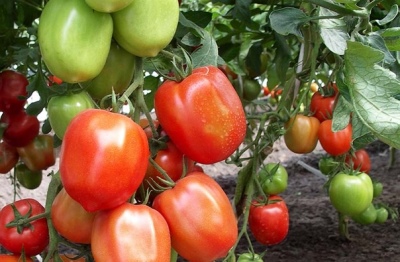
- Authors: Kamanin A.A., Potapov P.N.
- Year of approval: 2013
- Category: grade
- Growth type: determinant
- Appointment: fresh consumption
- Ripening period: mid-season
- Growing conditions: for open ground
- Bush size: undersized
- Bush height, cm: 60
- Bush characteristic: compact
The varieties of the Siberian collection are very popular. Unpretentiousness and the ability to successfully withstand difficult climatic conditions allow cultivation in conditions of a short northern summer with unpredictable weather. Tomato Nastya sibiryachka manages to grow and harvest in a short period. The berry is used fresh, sliced, in summer and winter salads, in canning. The determinant variety is intended for outdoor cultivation.
Breeding history
The originators of the variety are breeders A.A. Kamanin, P.N. Potapov; the variety Nastya Sibiryachka was admitted to breeding in 2013.
Description of the variety
Low-growing (60 cm) compact bushes are covered with medium-sized dark green leaves. Yellow flowers form intermediate inflorescences. The first fruit cluster appears above 10 leaves; in total, up to 12 clusters can form. The fruits are attached to the articulated stalk. The variety is intended for outdoor cultivation.
The main qualities of the fruit
Unripe fruits are colored deep green with a noticeable milky spot in the region of the stalk. At the stage of technical and physiological ripeness, the tomato acquires a bright raspberry color. Cuboid fruits have an average weight of 230 grams. Flowers are collected in simple inflorescences.
Advantages of the variety:
compactness;
versatility;
unpretentiousness;
strong immunity;
resistance to temperature extremes;
excellent commodity performance, stable yields.
It is difficult to find the disadvantages of this variety, if only to note the exactingness of watering, but this is a necessary condition for agricultural technology.
Taste characteristics
Medium density sweet pulp is covered with a smooth skin, high content (up to 7%) of dry matter makes it possible to dry the fruits, getting a tasty original snack. Tomatoes are distinguished by high commercial qualities, good transportation and long shelf life.
Ripening and fruiting
Mid-season ripening periods allow harvesting in July-August. The amicable return of the berry allows you to quickly finish with conservation and remove the fruits before the onset of nighttime drops in temperature and the activation of late blight.
Yield
The variety belongs to high-yielding - in a greenhouse, subject to the rules of agricultural technology, up to 12 kilograms of tasty berries are harvested from one square meter. In the open field, the indicators decrease, but they remain quite good - 8.3 kg per sq. meters.
The timing of planting seedlings and planting in the ground
Sowing seeds for seedlings is carried out in March-April, planting of young plants in a permanent place - in May-June.

Growing tomato seedlings is an extremely important process, because it largely depends on whether the gardener will be able to harvest at all. All aspects must be taken into account, from seedbed preparation to planting in the ground.
Landing scheme
The optimal planting pattern is 50x70 cm, but no more than 4 roots per square meter.

Growing and care
The plant is grown in seedlings, hardening young seedlings before planting in a permanent place. A plot in the garden is chosen sunny, with fertile and breathable soil. It is not recommended to use ground for tomatoes after growing peppers, eggplants, potatoes. The compactness of the bushes allows you to significantly save space on the site, giving freedom to more powerful varieties.
The soil is enriched with organic matter (chicken droppings, humus), complex mineral fertilizers, and wood ash. The variety does not require shaping and pinching; support may be needed if the bushes are pulling out too abundant crops. Then there is a danger of lodging of the stems.
Nastya Sibiryachka needs timely watering, regular weeding, top dressing, hilling and preventive treatments. Stable irrigation is especially important during crop maturation, but this does not mean that the soil needs to be turned into a swamp.
Nutrient additions are organized several times per season. The first feeding is done after one and a half or two weeks - at this time the plant needs nitrogen compounds. The second time tomatoes are fertilized in the budding stage, adding potassium-phosphorus mixtures to the soil. They have a good influence on the development of the culture of feeding with infusions of nettle or mullein.




A plant needs different micronutrients at each stage of growth. All fertilizers can be divided into two groups: mineral and organic. Folk remedies are often used: iodine, yeast, bird droppings, eggshells.
It is important to observe the rate and period of feeding. This also applies to folk remedies and organic fertilizers.
Disease and pest resistance
Nastya Sibiryachka is distinguished by good health, high resistance to late blight, although the tomato simply does not have time to wait for her - the fruits are harvested before late blight comes. In addition, it is practically not affected by bacterial and fungal diseases inherent in nightshade crops. In order to prevent the appearance of pests and signs of disease, it is necessary to carry out preventive treatments with insecticides and fungicides.


Resistant to adverse weather conditions
The variety, bred by Siberian breeders, withstands cold snaps quite well and is considered frost-resistant.
Growing regions
The variety grows well throughout the country. These are the northern, North-West and Central, Volga-Vyatka regions, the Central Black Earth Region, the North Caucasian, Middle Volga, Nizhnevolzhsky, as well as the Ural, West Siberian, East Siberian and Far Eastern regions.

























































































